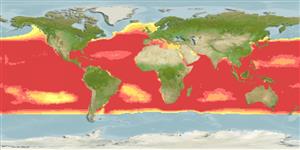Actinopterygii (peixes com raios nas barbatanas) >
Perciformes (Perch-likes) >
Scombridae (Mackerels, tunas, bonitos) > Scombrinae
Ambiente / Clima / Intervalo
Ecologia
; marinhas; oceanódromo; intervalo de profundidade 0 - 260 m (Ref. 9340), usually 0 - ? m (Ref. 55287). Tropical; 15°C - 30°C (Ref. 168), preferred 27°C (Ref. 107945); 63°N - 47°S, 180°W - 180°E
Cosmopolitan in tropical and warm-temperate waters. Not found in the Black Sea. Highly migratory species, Annex I of the 1982 Convention on the Law of the Sea (Ref. 26139).
Length at first maturity / Tamanho / Peso / Idade
Maturity: Lm 40.0, range 40 - 45 cm
Max length : 110 cm FL macho/indeterminado; (Ref. 89423); common length : 80.0 cm FL macho/indeterminado; (Ref. 168); Peso máx. publicado: 34.5 kg (Ref. 168); Idade máx. registada: 12 anos (Ref. 168)
Espinhos dorsais (total): 14 - 16; Raios dorsais moles (total): 14-15; Espinhos anais 0; Raios anais moles: 14 - 15; Vértebras: 41. Interpelvic process small and bifid. Body without scales except for the corselet and the lateral line. Swim bladder absent. The back is dark purplish blue, lower sides and belly silvery, with 4 to six very conspicuous longitudinal dark bands which in live specimens may appear as continuous lines of dark blotches.
Found in offshore waters; larvae restricted to waters with surface temperatures of 15°C to 30°C (Ref. 6390). Exhibit a strong tendency to school in surface waters with birds, drifting objects, sharks, whales and may show a characteristic behavior like jumping, feeding, foaming, etc. Feed on fishes, crustaceans, cephalopods and mollusks; cannibalism is common. Spawn throughout the year in the tropics, eggs released in several portions (Ref. 35388). Eggs and larvae are pelagic (Ref. 6769). Preyed upon by large pelagic fishes (Ref. 6885). Also taken by trolling on light tackle using plugs, spoons, feathers, or strip bait (Ref. 9684). Marketed fresh, frozen or canned (Ref. 9340); also dried-salted and smoked (Ref. 9987).
In tropical waters, reproductively active female skipjack tuna spawn almost daily.
Collette, B.B. and C.E. Nauen, 1983. FAO Species Catalogue. Vol. 2. Scombrids of the world. An annotated and illustrated catalogue of tunas, mackerels, bonitos and related species known to date. Rome: FAO. FAO Fish. Synop. 125(2):137 p. (Ref. 168)
Categoria na Lista Vermelha da IUCN (Ref. 115185)
CITES (Ref. 94142)
Not Evaluated
Ameaça para o homem
Reports of ciguatera poisoning (Ref. 4690)
Utilização humana
Pescarias: altamente comercial; peixe desportivo: sim
Ferramentas
Relatórios especiais
Descarregue XML
Fontes da internet
